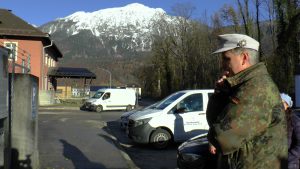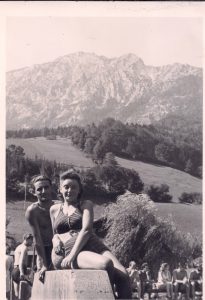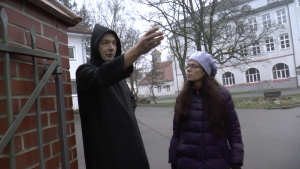JRep – February 19 34-37 dichek
A Place of Hope
Bernard Dichek
Bad Reichenhall and St. Ottilien, Germany

“This place was once known as Camp Tikvah, the place of hope,” says Col. Stefan Leonhard as he guides me through the main gate of the German army’s 23rd Mountain Infantry Brigade.
I am in the Bavarian town of Bad Reichenhall at the site of an often-overlooked chapter in the history of the Holocaust. After World War Two ended, the American army offered Jewish survivors shelter in the American-occupied zone of southern Germany. The camps were located mainly in the barracks of German military bases and came to be known as Displaced Persons (DP) camps. The lives of an estimated 250,000 Jewish DPs were in limbo for several years as they waited in more than 400 DP camps to find a country willing to accept them. Only in 1948 after Israel achieved its independence were Jews able to move freely to the Jewish homeland, and only then did the US and other Western countries ease their immigration restrictions. In the meantime, it was in the DP camps that many of the survivors, including my parents, married and gave birth to children.
I recently visited the sites of two former DP enclaves, Bad Reichenhall where my parents lived between 1946-1949 and St. Ottilien Archabbey, a monastery near the former concentration camp of Dachau.
Today, neither location has a Jewish population, but in both places I met local soldiers, historians and monks well-versed in the DP era.
Col. Leonhard begins my tour by commenting on the jarring presence of a sculpted eagle. The iconic symbol of the Nazi era towers over the entrance.
“Some people see this eagle and think that we are praising Hitler,” says Col. Leonhard. “But the reason we keep it is because you can’t change history. So in order to prevent it from happening again it is important for us to tell people about our history. We don’t see the Wehrmacht (Hitler’s army) as being our parent. We are not related. The Bundeswehr (modern German army) was born in 1955.”
We pass through an exhibit showing photos of present-day mountain brigadiers riding on mules at high altitudes and traversing snow-laden slopes. They are shown patrolling in the rugged terrain of places as diverse as Mali and Iraq.
Absent, as Col. Leonhard had implied, is any reference to German military activities during World War Two.
Students of history however, will know that in 1941 the alpine-trained soldiers from this base parachuted into Crete when Germany invaded Greece.
We next come to a plaque, initiated by Israeli artist Armand Beraru, indicating that about 6,000 Jews lived in Camp Tikvah between 1946-1951. For them and several thousand other DPs who were billeted in hotels and apartments throughout the town when the camp filled up, Camp Tikvah hosted a variety of activities that were crucial to the survivors’ rehabilitation. There was a Yiddish newspaper called Der Morgen, Yiddish theater groups, a Talmud Torah religious school and a Zionist-oriented school called Yavne.
Camp Tikvah also hosted several Zionist Congresses for Aliyah-hopefuls from across Germany. Among the guest speakers was the head of the Jewish Agency at the time, David Ben-Gurion.
But for many of the survivors, the period was best remembered as being the time when they married and started new families. Indeed historians estimate that in the late 1940s the DP camps had one of the highest birth rates in the world. Like young couples everywhere, the DPs were eager to take photos of themselves and their newborn. Bad Reichenhall, a spa town nestled in the German Alps, also offered plenty of opportunities for picture-taking.
“Ah, that is the Zwiesel,” says Col. Leonhard, as I show him a photo of my parents taken in 1947. In the picture a young couple clad in bathing suits poses in a swimming area overshadowed by an Alpine mountain. But as Col. Leonhard examines the photo a puzzled look comes over his face. “That clearly is a nearby mountain called the Zwiesel but I can’t place the location where they are standing.”

Col. Leonhard, whose 36-year military career has included tours of duty in Somalia and Afghanistan, is not easily deterred.
Determined to find the exact spot, but having to leave for his next meeting, he asks two soldiers under his command to accompany me on a search-and-identify mission in the neighboring countryside.
But the soldiers, after more than an hour of scouring mountain trails with me in a military vehicle, reluctantly conclude that the swimming spot probably no longer exists.
On the way back, one of the soldiers, a young corporal in his twenties, talks about his own experiences with refugees.
“During 2015 and 2016 we were in charge of looking after the refugees that came here from Syria and Afghanistan when they first crossed over the border from Austria,” he explains, describing how his platoon gave out food and played with the children. “It was difficult to see the condition they were in. They were exhausted after months of travelling by foot. Their worn-out clothing didn’t suit the weather here.”
When asked if he sees any similarities between present-day refugees and what he knows about the refugees that came to Bad Reichenhall after the war, he shakes his head. “There are similarities but you can’t really make a comparison.”
One parallel that does exist however is that some of the hotels used to accommodate the Jewish DPs in the 1940s are today housing refugees from the Middle East and Africa.
One of them is the Schroffen Hotel. Perched on a vantage point overlooking the city, the hotel today is in a dilapidated condition yet its exterior walls still boast colorful Gothic images that suggest better times.
In the corridor I meet Rashid, a Nigerian refugee who is recovering from hip surgery. He expresses gratitude about the extensive medical treatment he received at a Bad Reichenhall hospital. As a child rides by on a bicycle, he adds that his children have been well-treated in a local school. “I love Germany,” he says in summation.
The willingness of the local population to accept the present-day refugees is echoed by Monika Tauber-Spring, a member of the City Council, when I meet with her later on. Her own apartment is located in a building that once served as the hotel where my parents were billeted.
She points out that the City Council has adopted a policy of spreading out the refugees across the city. “One reason we feel that the refugees have been so well integrated is that we have avoided concentrating them in a single area,” explains Tauber-Spring. She notes that under the federal government’s refugee distribution program, Bad Reichenhall’s population of 18,000 has been allocated about 800 refugees.
Hearing about how the refugees of recent years were routed to designated locations, makes me wonder why Bad Reichenhall, out of more than 400 DP centers, was the one where my parents ended up. Did they choose it on their own volition or were they sent there by the American army? After a discussion with a local historian, one possibility that crosses my mind after is that my parents may have been drawn to the town because of its reputation.
“Bad Reichenhall’s pre-war population included many Jews, artists and intellectuals,” says Johannes Lang, the head of the municipal archives and the author of several books on the history of Bad Reichenhall. He points out that the town was known for its cosmopolitan, laissez-faire atmosphere. “Even during the war itself, people would say that if you wanted a good bottle of wine Bad Reichenhall was the place to get it,” notes Lang.
Lang mentions that he is frequently contacted by the children of Jewish DPs who are eager to find out more about the town where their parents lived and some of them were born. “I hope to one day organize a get-together for these families,” says Lang.
About 200 kilometers to the north, at the St. Ottilien Archabbey, plans for an event of this kind are already underway. The St. Ottilien Displaced Persons Conference and Symposium, to be held in June 2018, is expected to be attended by many of the 427 children born there to DP parents. In coordination with the Munich University Department of Jewish History and Culture, the conference will include lectures by leading researchers from around the world.
Surprisingly, one of the main organizers is a Benedictine monk.
Father Cyrill Schaefer rises early each morning for prayers at 5:30. His deep baritone voice fills the perfect acoustics of the 19th century monastery chapel as he conducts the mass on a misty November morning. Afterwards he guides me to a building that once served as a maternity ward and describes how the histories of the monastery and the DPs are intertwined.
“In 1941 the Nazis took over the monastery. They used the monks for slave labor and turned the monastery into a military hospital for wounded German soldiers,” says Father Cyrill. He explains that when the Americans liberated Dachau and the nearby Landsberg Kaufering concentration camps, the hospital was used to treat the beleaguered survivors, even while wounded German soldiers were still there.
As the monastery hospital acquired a Jewish medical staff and the German patients were phased out, the maternity ward soon attracted expectant DP mothers from many DP camps including Bad Reichenhall.

Other monastery facilities were used by the DPs for other communal functions. About a 100 meters away, Father Cyrill points to a building which housed a printing press. “This is where Rabbi Shmuel Abba Snieg and a group of yeshiva students edited and published what became known as the Survivors Talmud,” notes Father Cyrill.
As I leave St. Ottilien for the flight back to Israel, I reflect on how the trip gave me some new insights into the lives of my parents. I especially like the idea that my parents, in the aftermath of their ordeal, might have chosen easy-going Bad Reichenhall out of a desire to make the best of life, no matter what the circumstances.
I also am heartened by observing how Germany, which in recent years has absorbed more refugees than any other country, has become “a place of hope” for so many of the world’s dispossessed.
Looking one more time at the photo of my parents in front of the Zwiesel I feel that I now better understand what it would have been like for them to do something as ordinary as put on a bathing suit.
It doesn’t really matter that we didn’t find the actual swimming spot.
The Jerusalem Report Feb. 19 2018
Sidebar:
Home(less): The IRO Children’s Village Bad Aibling, 1948–1951
What happens to children who become orphaned in a foreign country during a war and have nowhere to go when the war ends? Home(less) is a recently-published book that tells the story of a unique DP camp in the ruins of a German air force base south of Munich that sheltered foreign children and teenagers who were found roaming the countryside after World War Two. They included Jewish children whose parents were killed in the Nazi death camps, the children of slave laborers from Eastern Europe and children from Poland with Aryan features that were kidnapped as part of the notorious Nazi Lebensborn program aimed at creating a racially-pure master race. Many were severely traumatized and distrustful of adults. Some had lived with the American soldiers that liberated them and picked up habits of smoking, drinking alcohol and black-market racketeering. There were tensions between the Jewish and non-Jewish children as a result of the former receiving seemingly better provisions in the form of kosher food. Those jealousies culminated in an attempt to bake a cake with needles in it intended for the Jewish residents.
In Home(less) German historian Christian Hoschler chronicles efforts made by the International Refugee Organization (IRO) to help the children get back on their feet and then eventually resettle or repatriate them. Hoschler uses colorful anecdotes to provide both a picture of dramatic situations and a summary of newly-developed rehabilitation techniques. The IRO, working with leading American and British childcare workers, devised many pioneering programs aimed at reintegrating the children into society. Some of these approaches remain relevant today as conflicts around the world continue to create displaced people, many of them homeless children.
B.D.
